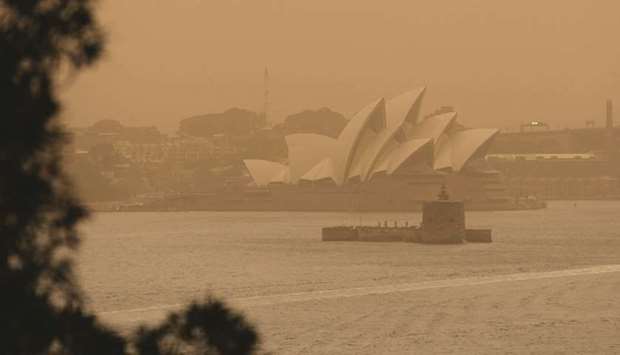Fires raged across a swathe of Australia’s east coast yesterday, destroying some homes and shrouding Sydney in smoke from a blaze authorities fear they will be unable to control until next week.
An aircraft was diverted to drop fire retardants on bushfires threatening homes in Sydney’s northern suburbs. Television footage showed some of the substance overshot the blaze, colouring houses and vehicles pink and red.
Officials were responding to 11 emergency warnings in New South Wales (NSW) by evening as around half the 70 fires across the state burned uncontrolled in conditions termed “catastrophic”.
“The task to bring these fires properly under control, to consolidate them, to get around them and mop them up is enormous,” New South Wales Rural Fire Service Commissioner Shane Fitzsimmons told reporters in Sydney.
“So we’ve got a long way to go yet before we can say we’re comfortable with the state of the fires ... particularly in northern New South Wales given the enormous size of the fires that are burning still.”
The extent of damage was not known, with dangerous conditions expected to continue into the evening and then occur again on Friday and early next week. Fitzsimmons said some firefighters suffered injuries, including fractures and heat exhaustion. Bushfires are a common and deadly threat in Australia’s dry summers but the ferocity and early arrival of this outbreak in the southern hemisphere spring has caught many by surprise.
Blazes have been spurred by extremely dry conditions after three years of drought in parts of NSW and Queensland, which experts say has been exacerbated by climate change.
The current outbreak, which killed three people and destroyed more than 150 homes at the weekend, has been fanned by an unprecedented combination of high temperatures and strong winds. Most of the emergency warnings issued by authorities yesterday, including for the South Turramurra fire 20km north of central Sydney, told affected residents they must seek cover and that it was too late to flee their homes.
In the small town of Wauchope, 400km north of Sydney, residents moved hundreds of livestock to the central showground as fires approached. “We have at least 350 horses, maybe more. They are still coming, we have cattle and sheep and chooks (chickens) and dogs, you name it,” said Neil Coombes, president of the Wauchope Show Society.
Coombes, who lives about 10km outside town, said he would likely lose his home because it was in the anticipated path of the fire. “My wife went home earlier and said, ‘is there anything you want me to get?’,” Coombes said.
“I said, ‘yes, I want you back here with me.’ If the house burns it burns, but I can’t replace her,” he said.
The worst of the weather was not expected until later in the evening or closer to nightfall, as winds whip up.
Firefighters were closely watching a blaze in greater Sydney, especially as aircraft operations will be grounded at night.
In Sydney, home to 5mn people, health authorities urged people with respiratory issues to stay indoors because the city was covered by a “hazardous” smoky haze.
Around 600 schools and colleges were closed across the state. NSW Education Minister Sarah Mitchell said nine public schools across the state’s north were evacuated. “Safety is first and we need to evacuate to get the children out of there,” Mitchell told the Australian Broadcasting Corporation.
The fires also forced organisers to cancel the season-ending Rally of Australia, which pitted Hyundai against Toyota. The danger was not quite as great in Queensland.
The threat level there was pegged at “severe”, two levels below the “catastrophic” conditions in NSW. Still, some 55 fires were burning across the northern state on Tuesday afternoon.
The threat has sharpened attention on the policies of Australia’s conservative government to address climate change, which meteorologists have said was extending the length of the fire weather season.
Prime Minister Scott Morrison, a vocal supporter of Australia’s coal industry, has declined to answer questions about whether the current fires were a result of climate change.
“The government says this isn’t the time to talk about climate change — I completely disagree, we should have been talking about this years ago,” said Carol Sparks, mayor of Glen Innes, north of Sydney, where two people died at the weekend.
“We are overwhelmed with the intensity of this fire and climate change is responsible,” she said.
Deputy Prime Minister Michael McCormack sparked debate on Monday when he accused activists, whom he called “woke capital city greenies”, of politicising a tragedy.

The Sydney Opera House is seen as smoke haze from bushfires drifts over the CDB in Sydney.
